Key Points
- Why is sustainable food packaging important?
- What does sustainable food packaging mean?
- What are the important features of sustainable food packaging?
- Sustainable food packaging: a step by step guide for brands
- Embracing custom sustainable food packaging design
Article Summary
Food packaging has a massive environmental impact, producing tons of waste, harming wildlife, and generating single-use plastics that fill landfills and oceans.
Consumers are ready for change. They want sustainable food packaging—but how can businesses meet these demands while maintaining profit, branding, and usability?
Steps toward sustainable food packaging include: switching to eco-friendly materials, reducing unnecessary packaging, getting inventive with design, and partnering with manufacturers, printers, and agencies who understand sustainable food packaging design.
Why Is Sustainable Food Packaging Important?

- 82.2 million tons—annual packaging waste in the United States alone
- 2,000—annual pieces of plastic packaging disposed per household
- 85%—percentage of plastic packaging that ends up in the ocean
Food packaging is responsible for a staggering amount of waste every year.
Traditional food packaging is full of materials like plastic, styrofoam, and other non-biodegradable substances—most of which are single-use, like wrappers and straws.
These single-use, unsustainable packages end up clogging landfills, polluting oceans, harming wildlife, and taking centuries to decompose.
By reducing reliance on plastic and opting for sustainable alternatives in their packaging, food and beverage brands can mitigate this environmental impact.
But sustainable food packaging isn’t just about corporate responsibility—it’s a smart business strategy.
Single-use plastics are versatile, cost-effective, and designed for convenience. They were created to meet growing demand fueled by consumerism—it’s easy to understand why they became so popular in the industry.
But with a recent surge in environmental consciousness and awareness, consumer trends are changing rapidly.
Consumers want to support responsible brands. In fact, they are increasingly prioritizing sustainability in their purchasing decisions:
- 82% of consumers are willing to spend more on products with sustainable packaging
- 71% of consumers report choosing a product specifically because of eco-friendly packaging
- 80% of consumers are interested in buying products in refillable packaging to lower environmental impact
Sustainable food packaging isn’t a niche trend anymore—it’s a must for brands who want to survive in the future.
What Does Sustainable Food Packaging Mean?
“Sustainable” has become a buzzword—but what does it really mean? What is “sustainable” food packaging?
Sustainability ultimately means preserving resources so that humans can coexist with the earth, now and for future generations.
A sustainable mindset understands that resources are limited and acknowledges that our actions impact the environment.
On our podcast, Entrepreneur Minds Speak, we discussed sustainable packaging with Saloni Doshi, CEO and Chief Sustainability Officer of EcoEnclose, a leading innovator in sustainable packaging supplies. (Listen to Saloni’s podcast.)
Saloni pointed out that there currently is no true “sustainable” packaging—all existing options are currently a net negative for the environment. She said that the future vision for sustainability is packaging that has a net zero or net positive impact on the environment.
To truly achieve this, packaging will need to change a lot. Saloni believes that truly sustainable packaging would fit two requirements. It would be circular (meaning that packaging would be made out of packaging and would become packaging again) and regenerative (meaning it would benefit the earth rather than harming it). For example, plastic made from seaweed is regenerative—seaweed cleans the ocean and supports marine life.

Saloni also emphasized that environmentalism is complex. We tend to focus on ocean pollution or landfills, but environmental impact goes beyond that.
There are impacts of all of our actions. For example, we often think of paper as “better” for the environment than plastic because it’s recyclable.
But the way paper is produced and sourced can contribute to deforestation—meaning it isn’t always better for the environment. (If your packaging contains paper, check to see that it is Forest Stewardship Council (FSC) Certified, so that you can be confident that it isn’t contributing to deforestation.)
Sustainability means thinking about the impact—from energy, ocean pollution, deforestation, air pollution—and considering what a net zero or net positive impact truly looks like.
We’re definitely not there yet—but that doesn’t mean that we can’t collectively transition to eco-conscious or “more sustainable” packaging.
Important Factors in Sustainable Packaging
To move toward sustainability, brands can make conscious decisions to reduce the environmental impact of their packaging. This could include minimizing waste, using fewer natural resources, reducing carbon emissions, and focusing on both recyclability and recycled materials.
While many brands have pivoted to recyclable materials, it’s important to remember that many recyclable food packages end up unable to be recycled due to food contamination.
Others don’t get recycled due to consumer confusion regarding what can and can’t be recycled.
Incorporating recyclable materials is a good step toward sustainability, but it isn’t the only one. Sustainable food packaging means considering the full lifecycle of products—from sourcing materials to disposal—in order to minimize environmental impact.
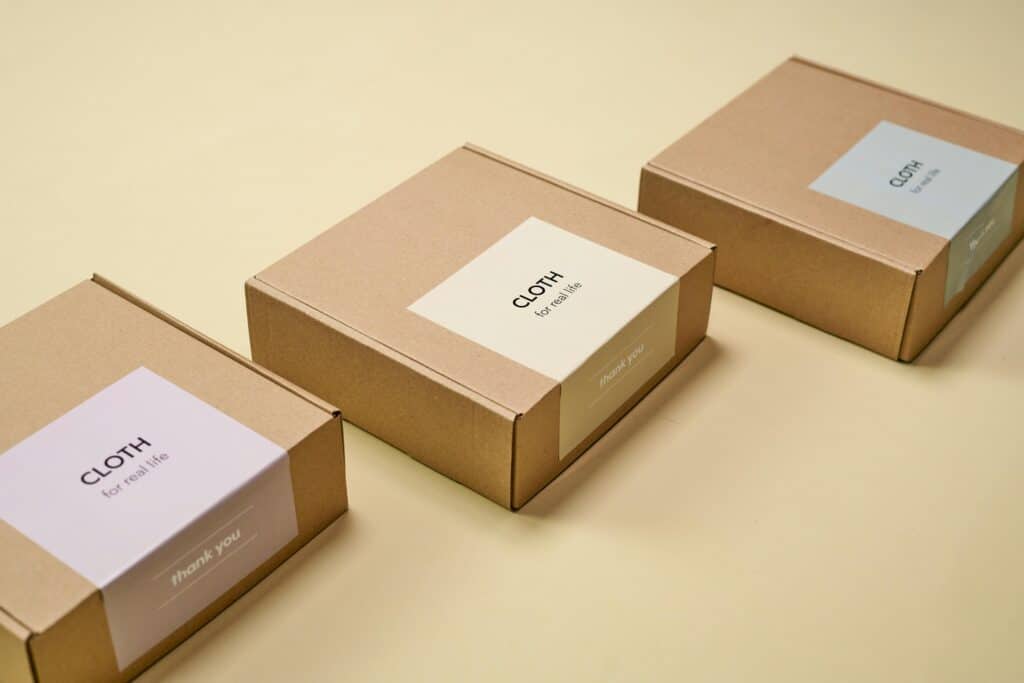
There are many ways to shift toward sustainable food packaging solutions, including:
- Reducing unnecessary packaging materials (opting for simpler designs that use fewer resources)
- Minimizing the use of plastics in packaging
- Switching to biodegradable or compostable materials
- Reducing carbon footprint involved with transportation
- Embracing reusable containers
Shifting toward sustainability can be as simple as substituting materials for eco-friendly alternatives, or more complex, using technology and innovation in design.
Your product, budget, and consumer’s needs and preferences will all play a role in what sustainability practices you can bring into your packaging.
Shifting to Sustainable Food Packaging: A Step-by-Step Guide
Sustainable food packaging doesn’t necessarily mean a full overhaul. Even small startups can find ways to transition to more sustainable food packaging. Here’s a step-by-step guide for how your brand can implement sustainable packaging:

Nossa Family Coffee transitioned from compostable to recyclable materials after realizing that, while compostable packaging initially seemed like a sustainable choice, it’s not always the most environmentally friendly option. Image credit by EcoEnclose
Step 1: Focus on Progress, Not Perfection
Truly sustainable packaging might still be a goal for the future, but even small steps can help reduce the environmental impact of your packaging.
The first place to begin is by taking a look at your existing packaging and thinking about where the biggest room for improvement lies. What about your current packaging is unsustainable? Is it plastics? Shipping fillers? Too many materials used?
You might have to start with just one area first—then transition to more innovative and sustainable options later down the line. Choose the simplest changes that make the biggest impact first—and remember that any progress can make a difference.
Step 2: Understand Your Budget
Before considering the switch to alternative materials, it’s important to get clear on your budget. Plastics are popular for a reason—and cost is one of them.
If you are going to embrace sustainable food packaging, you’ll almost definitely be increasing your cost per unit. The good news is that consumers are willing to spend a premium for sustainable packaging—meaning you can likely build the cost into your price.
Just remember, you still need to make a decent profit to sustain your business. (For help with your price point, profit margin, and other tips, see our Food Packaging Design Guide!)
Step 3: Swap Plastic for More Sustainable Packaging Materials
One of the biggest changes brands can make is reducing plastics in their packaging. Fortunately, brands have a wide range of choices for sustainable food packaging materials.

Popular sustainable food packaging materials include:
- Kraft paper—one of the simplest swaps for many businesses, Kraft paper works well for food wrapping and packaging. It usually comes at a low cost and it can be recyclable if not contaminated.
- Glass—there is a reason glass was once the gold standard of recyclable packaging. It’s fully recyclable, making it a solid option for beverage brands and jarred food products. However, there are drawbacks. Glass is fragile—and if you’re shipping your product, you’ll need to consider additional packaging to keep it safe. It’s also heavy, which can mean more shipping emissions and cost.
- Aluminum and metals—these are also highly recyclable, and offer a durable, reusable packaging option, especially in the beverage industry.
- Cardboard—a simple choice, but a solid one. Cardboard is a great option for shipping and for products that need outer packaging, such as granola bars and snacks.
- Bioplastics and plant-based materials—innovative options like seaweed-based materials, such as those developed by EcoEnclose and ZeroCircle, are the cutting edge of sustainable food packaging. Plastic-like material can be made from straw, woodchips, sawdust, or even recycled food waste.
- Compostable and biodegradable packaging—companies like Greenway Containers offer compostable materials, often in the form of high-quality cardboard, that break down without harming the environment.
Edible or plantable packaging—some innovative companies have designed plant-based packaging that can be planted or even eaten. Brands that opt for these packaging alternatives reduce their environmental impact and highlight a major commitment to sustainability.

Our packaging design for Megan & Co., a tea and supplement brand, used glass bottles and bamboo lids, reducing plastic.
Make sure that you research both the materials and the company producing them before making any changes. What might seem sustainable on the surface could be harmful on a closer look.
For example, corn-derived bioplastics became popular because they sounded sustainable, but in practice they took a negative toll on the environment. Another example is transitioning from plastic to paper. It might seem like a sustainable option, but it’s important to remember that paper has its own sustainability issues—if it’s sourced from endangered rainforests, it isn’t necessarily better for the environment.
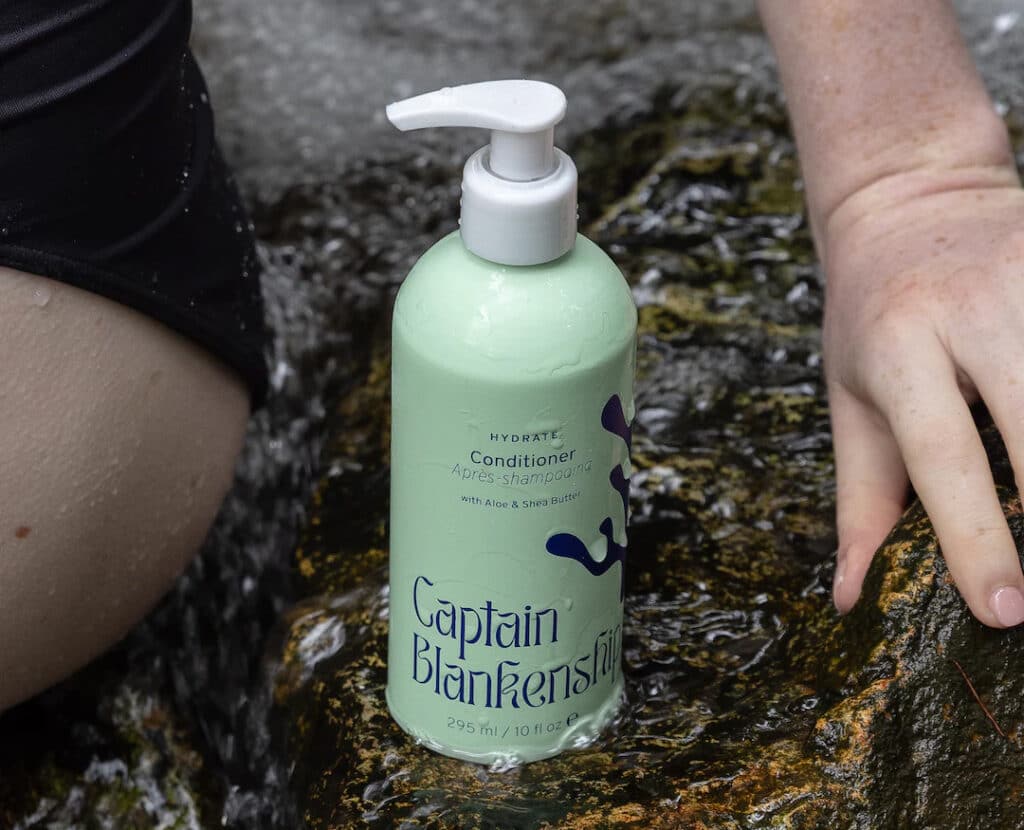
Through Captain Blankenship’s partnership with PACT Collective, they recycle not just the pumps from products but also any hard-to-recycle cosmetic packaging that might otherwise end up in landfills
Step 4: Think Beyond the Box
Your box, bag, bottle, or carton, isn’t the only area where you can pivot to sustainability. Labels and dyes can also make a big impact.
Traditional labels held food packaging back from moving toward sustainability—even when boxes or bottles were recyclable, the label wasn’t. But companies like Smart Solve are creating water-soluble labels that essentially disappear, leaving no lasting trace behind.
Synthetic dyes in packaging require a lot of water waste—and they also leak into the oceans, potentially harming marine life.
But vegetable-based dyes are more biodegradable and environmentally-friendly than synthetic dyes. EcoEnclose’s sustainable ink produced from algae cells is one of the first options to have a net negative carbon technology.

EcoClose’s algae ink is one of the leading innovative sustainable dyes in packaging.
The process of creating “Algae Black” pigment involves growing algae which actively absorbs carbon dioxide from the atmosphere, effectively capturing more carbon than is emitted during production, resulting in a negative carbon footprint when used as an ink.

Our eco-conscious packaging design for Simply Sharon’s used a biodegradable, compostable plastic pouch with recycled paper and vegetable inks for the tag.
Some natural dyes can even help detect product freshness, changing colors to indicate whether a product is still good!
Step 5: Pivot to Recycled Materials
Pivoting from virgin material (made from raw materials that haven’t been processed before) to recycled material is a big step toward sustainability.
Any time that we can give new life to old packaging or create materials from waste or previously used products, we’re moving toward the circular standard of true sustainable packaging.
Consider using packaging made from recycled paper or other material that has already been used. Just remember that there are potential drawbacks. Printing shows up differently on recycled material—so you will need to consider that in your packaging design. Also, recycled material is typically not as strong as virgin material—so depending on your product, this switch might not be feasible.
Step 6: Prioritize Functionality
If you asked leading packaging experts the question, “What is a particularly important feature of sustainable packaging?” would you expect to hear that the answer is actually functionality? It might be surprising, but this is actually the most important aspect.
No matter how eco-friendly your packaging is, at the end of the day, it still needs to be practical and usable. Consumers expect sustainability, but not at the cost of the user experience.
For example, paper straws seemed like a great alternative compared to plastic straws—until people tried to use them. They became soggy and dissolved within just a few minutes, causing consumer frustration.
This can also be an accessibility issue—consumers with disabilities that impacted their dexterity struggled when states started banning plastic straws.
Furthermore, not all options are practical for every product. You can’t sacrifice hygiene or food protection for eco-friendly packaging. Sustainable food packaging needs to be functional, durable, and capable of preserving the product as effectively as traditional packaging.
Step 7: Reduce Unnecessary Packaging
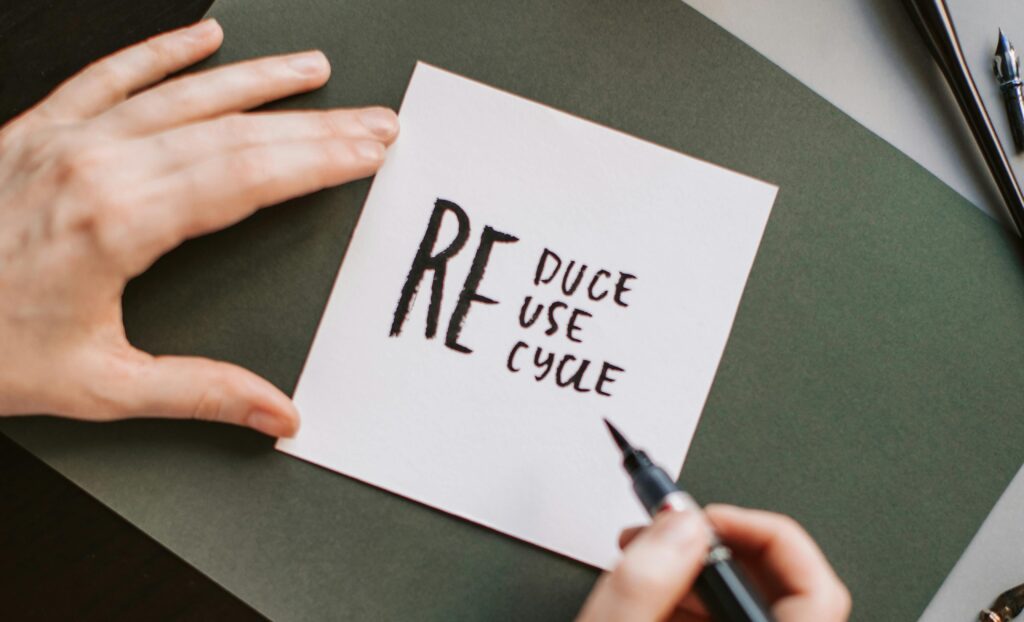
One of the most important features of sustainable packaging is reducing waste. And the simplest way to avoid wasteful packaging is to use less of it.
Often, food products come wrapped in layers of plastic or filler materials that aren’t needed. For example, cereal that comes in a sealed plastic bag and an outer box—it might look nice, but is it necessary? Is there a better way to package your product efficiently?
Brands are often tempted to use bigger packaging than they need to take up shelf space and command consumer attention. Bigger packages might make consumers feel like they’re getting a better value even when they aren’t—a packaging psychology phenomenon.
But many brands are shifting to “right-size” packaging, using only the amount of material necessary to protect the product. This reduces cost and waste—and it can also appeal to customers who feel frustrated by larger packaging that seems misleading when it contains less product.
Right-size packaging also protects food items better, resulting in less damage—this can lead to more trust and brand loyalty as well.
Think about what is absolutely necessary for your product and whether you can use sustainable packaging design to minimize waste. This can also reduce cost depending on the materials you choose.
Step 8: Consider Going Reusable
Reusable packaging is one of the best approaches to sustainability. Refillable coffee pods, reusable water bottles, refillable pouches for baby food—these products are popular because consumers can buy them once and reuse, reducing the need for new packaging.
In the food industry, reusable packaging can be tricky. Hygiene concerns and federal laws to protect public health might not allow for all brands or products to move in this direction. But depending on your product, this could be a great option.
Many brands will sell products such as quinoa, tea, or coffee in jars or display tins for initial purchases, then ship refills in minimal packaging. Coca Cola has rolled out a returnable bottle system, cleaning and reusing bottles. They have goals to increase this system—and have a dedicated space on their website to help educate consumers about the impact of reusable packaging.
Step 9: Reduce Your Brand’s Shipping Footprint
Selling directly to consumers can help you take advantage of e-commerce popularity, but it also comes with increased waste. It’s even more important for e-commerce brands to do their part to reduce their carbon footprint.
If possible, switch to shipping boxes that are made from post-consumer waste or recycled materials. Companies like EcoEnclose offer a range of stock and custom options.

Sustainable packing tapes are made from eco-friendly materials like recycled paper, water-activated adhesives, and cellulose, offering a responsible alternative to traditional plastic tapes. These tapes can be either biodegradable or recyclable, minimizing environmental impact. When choosing sustainable packing tape, consider its strength, adhesion, and any relevant certifications like FSC or PEFC, ensuring it meets your packaging needs while being kind to the planet. Image credit by EcoEnclose.
Choosing lighter materials or opting for fillers such as biodegradable packing peanuts, such as SpiroPack, can also help reduce waste and limit shipping emissions. Committing to right-size packaging for shipping materials as well as your product packaging can also make a big difference.

SpiroPack is a more sustainable filler alternative—the flat design takes up 80% less space on your packing station than crinkle shred, allowing for smaller, more lightweight shipping options.

Australian wine brand Accolade has been one of the pioneers in the alcohol industry to embrace more sustainable packaging. They embraced PET bottles for Hardys, one of their popular wine labels. The bottles themselves are flat, making them easier to ship and store, and the switch to PET resulted in a 50% reduction in emissions over their previous glass bottle.
Step 10: Label Your Packaging Transparently
Consumers want to support sustainable product packaging—but they can’t do that if they don’t know about your impact and efforts. Highlighting your commitment on your packaging tells consumers that their purchase makes a difference.
However, terms like “sustainable packaging” are not only inaccurate, but can also feel untrustworthy or controversial.
Misleading packaging could harm your reputation—and might even lead you into legal trouble. In the United States, sustainability labeling isn’t heavily regulated yet, but that will likely change in the future. California has passed laws restricting the use of the recycle symbol and labeling your package as biodegradable or compostable—and more states will probably follow.
It’s better to be more specific, avoiding empty claims and showing your understanding of eco-conscious packaging. For example, instead of labeling your packaging with “sustainable packaging,” you could label it with “made from 70% recycled material.” The more specific and accurate you can get, the better.
In a four-year study on sustainable packaging, claims were divided into three categories—high specificity (for example, “carbon zero” or “made from 100% post-consumer waste), medium specificity (for example, “sustainable packaging”), and low specificity (for example, “environmentally sustainable”).
Products with highly specific claims sold 8.5% more than products with no environmental claims. Those with medium specificity sold 4.7% higher than products with no claims, and products with low specificity sold only 1.2% higher than those without claims.
Remember that consumers aren’t just eco-friendly—they’re also savvy and skeptical. Brands that fall into “greenwashing” (claiming sustainability without making a genuine impact) run the risk of isolating customers and damaging their reputation.
Consumers are even using apps like Giki Zero to scan retail products and see the impact they have on the environment.
That’s why staying authentic is important. If your brand is committed to sustainability, include that in your messaging—but if you’re featuring it, make sure it’s accurate.
Step 11: Partner with Manufacturers who Embrace Innovative Design
If your budget allows for custom sustainability design, consider going innovative. Some sustainable food packaging companies are leading the future, manufacturing out-of-the-box solutions for sustainable food packaging.
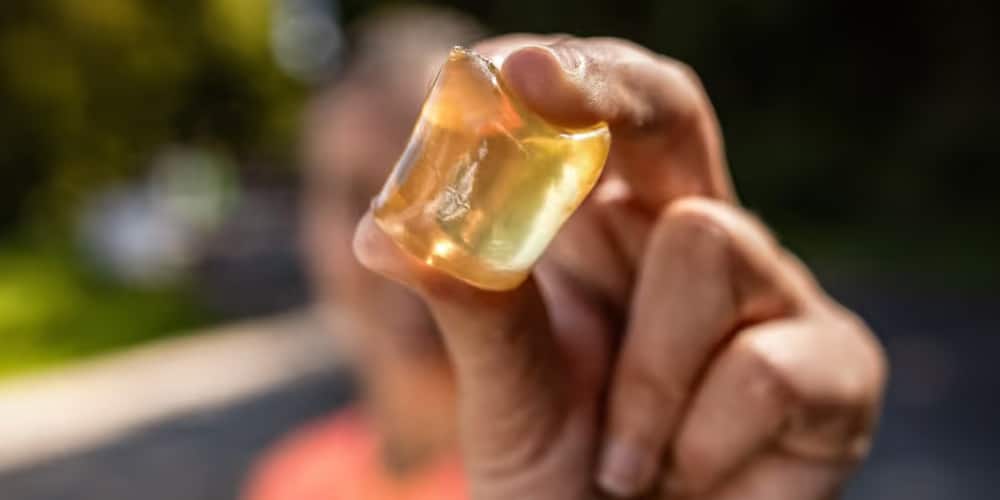
Inspired by nature, Notpla’s groundbreaking solution provides a sustainable alternative to single-use plastic packaging. Its innovative design encapsulates liquids in a thin, flexible layer that is both 100% naturally biodegradable and completely edible.
Notpla’s “disappearing packaging” is made of 100% natural seaweed—it can be fully composted after use, leaving behind no lasting environmental impact.
SmartSolve creates water-soluble labels and flexible snack packaging that can be composted or even flushed. (Listen to our podcast with Alex Abbott from SmartSolve where he shares new approaches to sustainability.)
Gualapack is also targeting flexible snack packaging through recyclable materials, creating fully recyclable baby food and applesauce pouches.
Australian brand Alba Cheese has switched to biodegradable stretch wrap invented by BioGone, eliminating plastic wrapping from their packaging.
EcoEnclose creates recyclable and fully recycled packaging, including recycled tissue paper, corrugated bubble wrap alternatives, and poly mailers made from post-industrial waste (material used during other manufacturing that would otherwise be disposed of). See their samples and our podcast interview here.
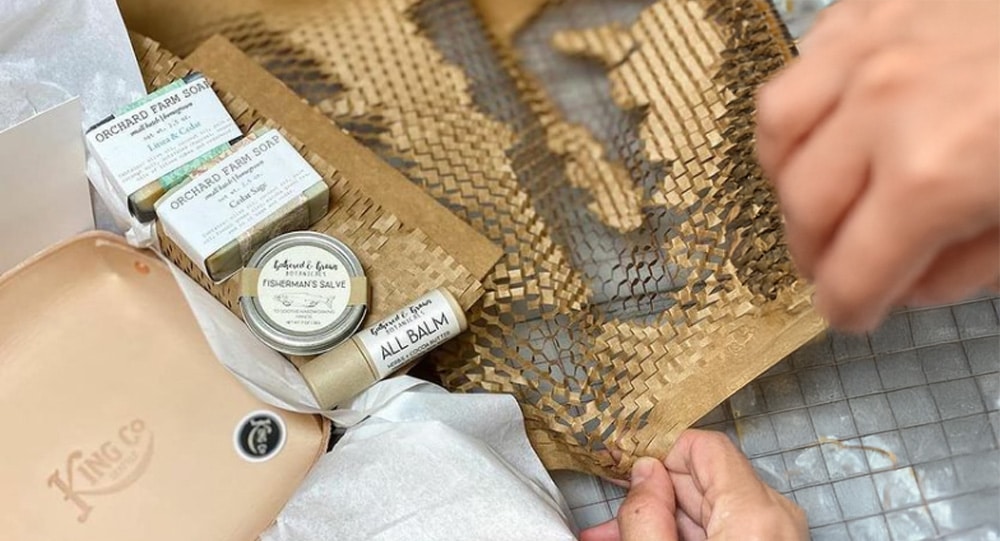
GreenWrap Honeycomb Paper is a plastic-free, curbside recyclable alternative to bubble wrap® that offers similar cushioning and protection. Image credit by EcoEnclose.
Sway’s seaweed-derived compostable plastic alternative is regenerative, contributing to the environment rather than harming it.
Zero Circle creates plastic and paper alternatives from seaweed with the goal of reducing harm to ocean life.
The Sustainable Packaging Coalition works with brands to push the envelope and find creative ways to meet the challenges of eco-friendly packaging without sacrificing aesthetics or durability.
Step 12: Work With a Designer Experienced in Sustainable Packaging
Overall, brands want to embrace sustainable food packaging—but knowing how to do that is another matter altogether. Surveys show that 75% of existing brands have created sustainability goals for themselves—but that only 30% of them reach their goals.

Image credit by EcoEnclose
That’s why it’s important to work with partners who understand sustainability. Eco-conscious packaging design goes beyond swapping materials—it also requires maintaining branding, understanding the way materials might affect your products, and considering how to design packaging that strikes a balance of functionality and sustainability.
An experienced packaging design agency will understand eco-friendly materials and how they might impact design. For example, vegetable dyes might produce slightly different color variations, or different labeling options might work better on glass versus plastic. Some materials might function better for specific products or use cases.
Design agencies that know about these nuances can guide you through the process and offer valuable insight. They can also create unique ways to powerfully feature your commitment to sustainability on your packaging and in your brand messaging.
Custom Sustainable Packaging Design
If you want to truly establish yourself as an eco-conscious brand, consider us for your custom sustainability packaging design agency.
As an experienced eco friendly packaging design company, Crème de Mint can work with manufacturers to create customized sustainable product packaging that is practical, inventive, and attention-grabbing.
You don’t have to sacrifice branding for sustainability—you can create custom solutions that protect your product, maintain your brand image, and show consumers that your brand is showing up for them and the environment.



